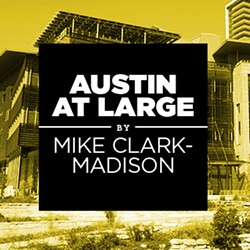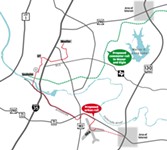Austin @ Large: Switching Tracks
Even Union Pacific wants to get out of the way of the Krusee Express
By Mike Clark-Madison, Fri., April 9, 2004

This isn't quite like Nixon going to China, unless Union Pacific is cast in the role of the Chinese. The UP's reported cost estimate – to be paid by you and me, at one or another level of government – for relocating simply the Austin segment of the route (through Williamson, Travis, and Hays counties) is $500 million; that tag grows to $700 million to also move the segment south of San Marcos. This phasing reflects that of State Highway 130, although earlier assumptions that the SH 130 corridor could, would, or should include freight-rail right-of-way have apparently not swayed Union Pacific, whose current proposal would instead shift rail traffic to its existing line through Taylor and Bastrop.
Nor does UP seem to fully buy into the argument – advanced by supporters of the railroad's own proposal – that moving to an upgraded eastern line, and abandoning its existing aging facilities and scores of at-grade crossings in the guts of the region's largest cities, would lead to an increase in railroad traffic. Boosters of the UP plan – or, more precisely, of the other projects that the UP plan would enable – point to the opportunity to increase overall freight-rail traffic, thus taking trucks off the road and their fumes out of the air. But operationally, Union Pacific – which came rather close to a total meltdown of its Central Texas services in the late 1990s – seems much less concerned about getting more trains, more quickly, through Austin than it (rightly) is about its current service struggles in the Metroplex and in El Paso. Even after UP delivered its plan to local and state leaders, its spokesman told the Austin Business Journal what the railroad has said for years – that any plan had to "ensure that the level of service has to meet or beat what's already there."
New Age Krusee?
What is like Nixon going to China, though, is the shift in the partisan political dynamic that appears to have finally gotten UP's attention. It can be tricky to track the new calculus, since for a generation the official line has been that Central Texas needs a multimodal transportation system that includes significant new investments in both roads and rail and parallel changes in land use – this last point being just recently underscored by Envision Central Texas. That is still the official line, but now people in power actually show signs of believing it. And, you may have noticed, the people in power in this region and state are suburban, pro-business Republicans, the kind of people Union Pacific – whose largesse was allegedly spread thick on the House floor by Tom Craddick himself – views in friendly terms.
Foremost among these is state Rep. Mike Krusee, R-Taylor, who upon arriving at a political crossroads some years back took the road less traveled, so to speak. And, as in Frost's poem, that has made all the difference. Though Krusee has always been a different kind of elephant – more of an intellectual and a policy wonk – than your average suburban Texas Republican, in his earlier elected years he spent plenty of time glowering at Austin Democrats from the far side of a partisan abyss, particularly on the issue of transportation. (Next time you spend hours looking at taillights in the Northwest Corridor, thank Krusee, who wrote a bill that banned Austin from requiring traffic-impact studies on developments in the area.)
So from Austin's side of the road wars, Krusee wasn't the worst of the bad guys, but he was a bad guy. Now, surprisingly, he isn't, and not just because times have changed. Talk of Krusee's conversion into an ECT-friendly New Urbanist sympathizer is common in Austin progressive circles, and it's quite clear that his direct and ongoing intervention has saved Capital Metro from its enemies and kept Austin's transit hopes alive. Instead of cashing in his GOP chips and running for Congress in the Williamson Co. seat ostensibly drawn for him, or otherwise looking out for No. 1, Krusee has spent the last four years working a lot harder than most of his peers, and on a notably unglamorous issue – actually trying to solve Austin's and Texas' chronic transportation problems in a sincere way amenable to both sides.
Multimodal Politics
It is true that many of the state's transportation strategies that Krusee has been tasked with – regional mobility authorities, toll roads, and the ludicrous Trans-Texas Corridor plan – leave much to be desired and are justifiably controversial. But the opportunities they pose for fiscal and contractual mischief do not completely negate the possibilities they offer for changing the most awful habits of the hidebound Texas highway herd. We should be able to build and manage multimodal transportation systems as single entities, expect competition and innovation among the people seeking to design and build them, oversee their planning and development across local jurisdictional lines without having to go through TxDOT, and, yes, look for ways to recoup their costs directly from the people who use them, instead of soaking the entire populace.
It was Krusee who solicited a relocation plan from Union Pacific, and it's pretty obvious that – no matter what die-hards on both sides would rather see – both road and rail infrastructure would be put in UP's place: high-occupancy toll lanes down the center of MoPac, accompanied by the local leg of the long-contemplated Austin-San Antonio commuter rail system, with a Downtown hub somewhere near Seaholm Power Plant. It's also pretty obvious that the only way Austin will ever have rail transit is if we start with a commuter system serving western suburbanites, and that the only way to handle the auto traffic produced by ECT-level urban densities is to add high occupancy toll lanes to I-35 and MoPac. So I suggest we look for ways to make the UP deal work. Many local leaders seem to agree, given the alacrity with which they threw the deal on the table when they went to Washington last week – and the equal speed and vigor with which it was picked up by, yes, suburban Republicans like Kay Bailey Hutchison and Lamar Smith.
There, my friends, is your story. As Dallas and Fort Worth have now demonstrated to all but the willfully obtuse, density and transit-oriented development, supported by both roads (including toll roads) and rail, can and do work in the suburbs. And the GOP base in those suburbs – which includes lots of people who had no other real homeownership options – is starting to make the connection between affordability and tax equity, the quality of public services, ill-regulated land use, and auto dependence. (They're still not quite sold on toll roads – which can be a perfectly good way to influence land use along highway corridors – but that's to be expected.) Ten years ago, Williamson Co. just wanted more roads, Austin wanted no roads, and players like Union Pacific ignored them both in the inevitable stalemate. But a multimodal plan with support in both the city and the suburbs? You don't want to be in front of that train when it comes hurtling through. And neither, apparently, does Union Pacific. ![]()
Got something to say? The Chronicle welcomes opinion pieces on any topic from the community. Submit yours now at austinchronicle.com/opinion.








